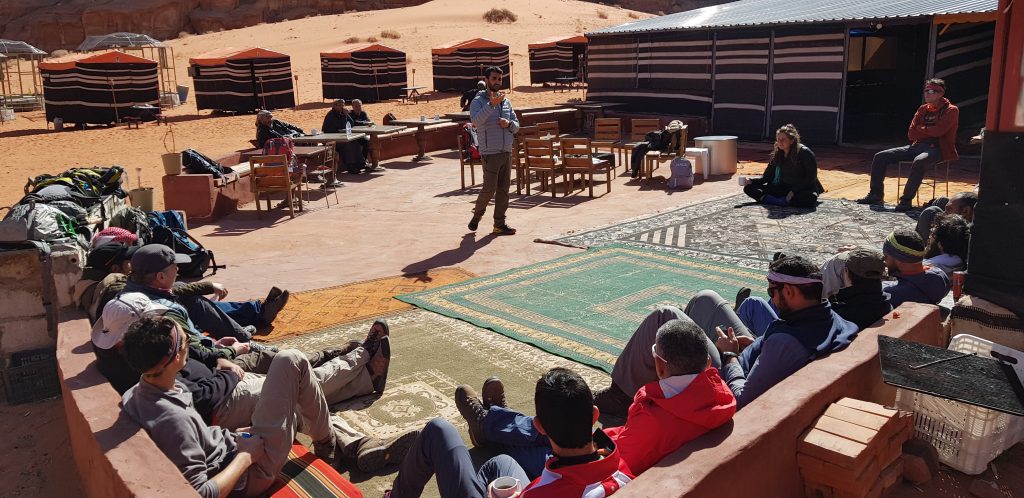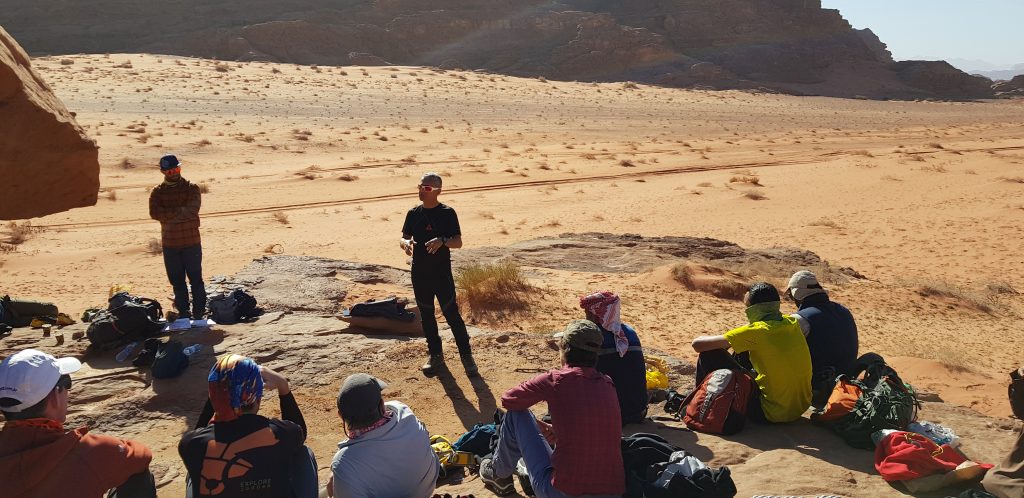It is 11:00 a.m. in Wadi Rum, the otherworldly landscape painted in shades of orange against a backdrop of mountains and desert. Fifteen of the best adventure guides in Jordan have just completed a two-hour trekking navigation and orientation session and are now preparing to learn how to teach content delivery and natural and cultural interpretation.

Two trainees are selected to demonstrate to the group how to be educators using the local landscape and culture as an example. One tells the group his approach is to help people see through the eyes of the local Bedouins: Find the strategic places where there is shadow and water; a place where you have a sweeping view of the landscape and can see everything with eagle eyes while avoiding strangers. The other trainee takes a different approach, explaining the landscape from a geological perspective: Imagine that 1.5 million years ago all of this was sea, and 1.5 million years in the future, everything the group sees will be a sand dune desert.
When both have finished their outstanding commentary, the trainer takes advantage of the moment. He asks the other trainees what they learned from the presentation styles, what worked well, and what needed improvement. Adopting this experiential learning approach of training the trainer is one of the key elements of the Adventure Travel Trade Association’s (ATTA) AdventurePro project that recently concluded in Jordan.
In June 2018, the ATTA partnered with USAID Local Enterprise Support to provide Jordan with training and guidance to develop the destination’s adventure travel potential. This expansive project included localizing international adventure tourism standards, developing a certification scheme for adventure leaders, providing training to adventure leaders, implementing a safety and risk management culture in adventure tourism products, and supporting the country to design better regulations for the adventure tourism sector.
Jordan has experienced remarkable adventure tourism growth. The Jordan Times reported visitors to Petra and Jerash, two of the country’s most well-known tourist attractions, were up 50% in March 2018 over March 2017. In addition to significant growth to mainstream destinations, demand for tourism experiences with a deeper connection to the local culture and landscape — adventure tourism — is also growing. Further, 96% of adventure tour buyers participating in AdventureNEXT Near East 2019 said they are interested in creating new itineraries to the country. They also expect to send 50% more travelers to Jordan next year than they did in 2017.
"Adventure travel in Jordan is just starting to reveal its potential. The standards and training in the country elevated the guides and companies to the next level of maturity and professionalism,” said Gustavo Timo, the ATTA’s destination development director.
Research conducted by USAID Local Enterprise Support suggests adventure tourism is key to Jordan’s economic security, creating jobs that are sustainable and resilient to market shocks. In one report, the organization’s analysis indicates the industry is capable of generating “well over $10,000,000 USD in direct and indirect revenue generation for micro- and small-enterprises (MSEs) in Jordan, most of which directly contributes to local economies.”
Given the rapid and expanding interest in adventure tourism in Jordan, tourism ministry leaders along with international aid organizations are mobilizing to bring more structure and organization to the sector. It’s within this context that the ATTA worked to introduce best practices for safety in Jordan by delivering already established global ISO standards for adventure tourism. These established standards consist of safety management systems for companies, general competencies for guides, information that needs to be provided to clients, and sustainability guidelines and practices.

“We introduced the ISO standards to Jordan with a kind of localization of the standards. They are adapted to the local reality of what is needed,” Timo said. “We also brought some competency standards for adventure travel guides because, in Jordan, there was a lack of reference for adventure travel guides. We helped the country establish what competencies are needed — skills, knowledge, behavior — when guiding.”
Once the ATTA introduced these established standards, all destination stakeholders (including guides, company owners, government, and other non-governmental organizations) gathered to determine what the standards for adventure travel tourism in Jordan would be. Guides then underwent training focused on these standards.
“From the training courses, we trained the trainers. We selected guides from among the guides that were trained to become trainers. We then did training for these selected guides, teaching them how to instruct other guides,” Timo said. It’s this approach that will ultimately create a sustainable adventure tourism industry in Jordan.
“We developed a capacity-building approach in Jordan so that the adventure travel sector can, on its own, move forward with training other guides, building capacity, and being more competitive. They’ll also be able to spread the culture of quality, safety, and sustainable guiding in the adventure travel sector in Jordan,” Timo said.
Ultimately the ATTA’s role was to facilitate a way for the adventure tourism industry to grow in a safe and sustainable way.
“The challenge is to bring all of the expertise, knowledge, and methodologies to their reality — to be able to adapt and understand how the local mechanics and context work — and then be flexible enough to shape the approach to that reality,” Timo said. “You can really build something meaningful and useful, and that can be a long-term solution for the country. It’s not only about the project you’re working on, where you deliver what you’ve got and you go away. You’ve got to do it in a meaningful way so people will buy, engage, and make that project their own.
“They are the owners of the solution; we are just the facilitators,” Timo said. “We brought the experience and expertise we have to help make the country competitive.”
Jordan is on the right path for uncovering long- and short-term economic growth through adventure travel. Developing the country’s competitive assets, introducing global references, building consensus on standards, training guides and companies to adopt sound practices, laying the groundwork for a safety and management culture in adventure travel, and helping the government to understand the sector is a strong start for grounding Jordan’s economic growth in this flourishing tourism sector.
